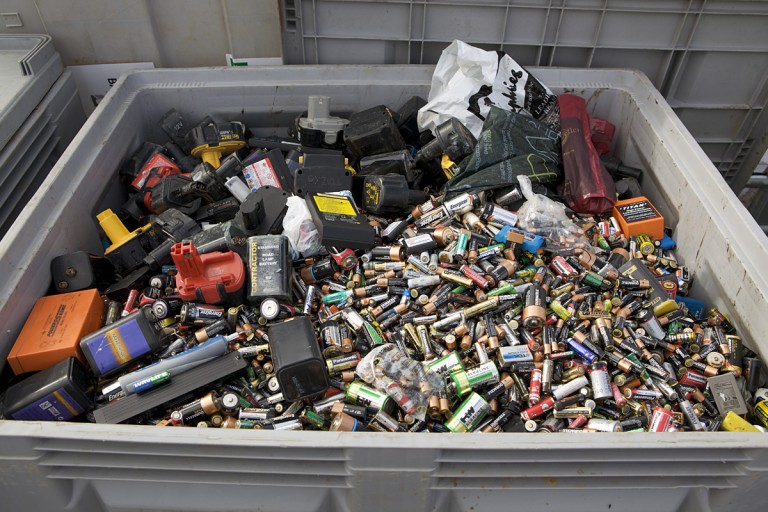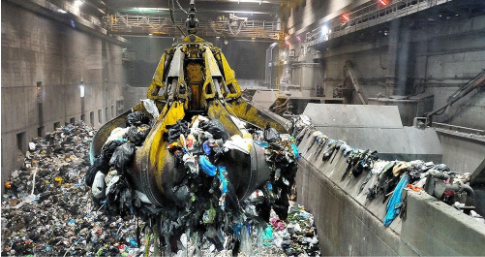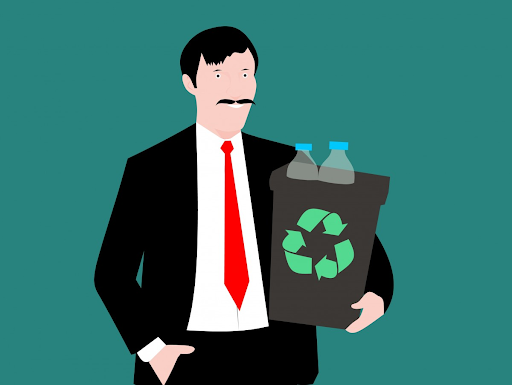SYMBOLS FOR IDENTIFICATION OF THE RECYCLING PROCESS
Recycling is a process of turning waste into new materials and products. It is an alternative of the conventional waste disposal. Recycling can prevent the waste of potentially useful waste materials and help reduce the extraction and processing of natural resources, thus reducing greenhouse gas emissions, energy consumption and pollution of environmental elements – air, water and soils.
Recycling is a key element in the modern waste management and it is the third priority in the hierarchy of waste activities: “Prevention → reuse → recycling → other recovery → disposal“.
The benefit of waste recycling is indisputable, both in environmental and economic aspect. This has also been reflected in the Concept of Circular Economy of the European Union. The Circular Economy is a model aimed at extending the lifespan of products. In practice, this means the longest possible sharing, boring, reuse, repair and recycling of the existing materials and products.
When a products reaches the end of its life, the materials from which it is composed continue to be used in another way. If this is done repeatedly, the waste disposal will be greatly reduced. With the adoption of the Circular Economy Package in 2015, the EU aims to make its economic model more sustainable. The package includes new legislative proposals on waste and an Action Plan with the related measures for every stage of the production cycle (from the design, production and use of goods to the waste management and their recycling). The European Commission plans to increase household waste recycling to 65% by 2030, at least 75% of packaging waste to be recycled /with specific targets for the individual streams/ and to limit to 10% the disposal of municipal waste.
A key element in ensuring the execution of these ambitious goals is the availability of information related to recycling opportunities for different types of waste. Which of them can be recycled? Which are not recyclable?
An essential part of this information can be obtained from the recycling symbols with which the goods and products are marked, which are visible on the goods we use or on the packages in which they are marketed.
SYMBOLS INDICATING RECYCLING
International recycling symbol
The international recycling symbol is a widely used symbol used to designate recyclable materials. It consists of three „chasing“or „pursuing“ arrows that form the so-called Mobius strip with triangular outline symbolizing the circle of nature and the closed cycle („creation – use – processing“).
Different variations of the symbol are used, as some of them are presented below. The arrows can only be filled in color or added with contour.
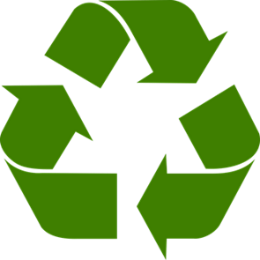 Recycling symbol without a contour and with green filling | 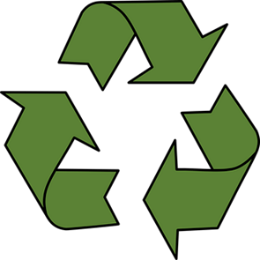 Recycling symbol with black contour and green filling | 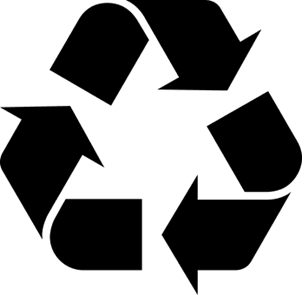 Recycling symbol with black filling |
History of the symbol: The idea of creating a symbol to designate recyclable materials is of the Container Corporation of America (CCA) Chicago Company – a large manufacturer of recyclable cardboard. In 1970, the company sponsored a competition for students of arts and design at colleges and universities in the USA to create a sign symbolizing the recycling process to raise awareness of environmental issues. The contest was won by Gary Anderson, a 23 year old student from the University of South California, located in Los Angeles. Anderson’s initial suggestion was a symbol in which the arrows form a triangle that stands at its top (with head down), but upon the adoption of the design, CCA rotated the triangle to 60˚, so it could stand on its foundation.
Gradually, this recycling sign started being used outside the USA and nowadays it is adopted as an International recycling symbol. The symbol is not a trademark and it can be used by all, it can be modified and distributed without the need of permission from the authors and without violating their rights. Furthermore, the use of the symbol is completely free of charge.
Identification code of plastics
The Plastics Identification Code /RIC/ was developed by the Society of the Plastics Industry (SPI) of the USA in 1988 to meet the needs of recycling enterprises and of the manufacturers of plastic products to create a consistent and unified coding system. The purpose of the system is to make it easier for the workers in material recovery and recycling facilities to sort and dispose of items according to the type of plastics.
Plastics must be recycled separately from other similar materials in order to preserve the quality of the recycled material and to allow its reuse in other products once it has been recycled. The plastics identification code is used to indicate the type of polymer used in the manufacturing process of the product or the packaging.
The SPI symbols are based on the international recycling symbol but they have simpler arrows (instead of folded) that are formed in a flat, two-dimensional triangle. In the triangle, one digit from 1 to 7 is placed, indicating the specific type of plastics from which the products is made:
| • “1” means that the product is made of polyethylene terephthalate (PET or PETЕ) – for example, drinking bottles (mineral water, non-alcoholic beverages and other fizzy drinks) and cough syrups, cups, etc. |  |
| • “2” means polyethylene with high density (HDPE) – it is used for the production of bottles, including milk bottles; cups; freezer bags; shopping bags; ice cream boxes; bottle caps of mineral water; shampoo packs and packs of detergents; waste bags; pipelines for irrigation of agricultural production; wood-imitation products, etc. |  |
| • “3” means polyvinyl chcloride (PVC or V) – it is used for the production of bottles for storage of non-food products; packaging for cosmetic products; pipes, including for sewerage; flooring; joinery, shower curtains; insulation of electric appliances, etc. |  |
| • “4” means polyethylene with low density (LDPE) – plastic bags, various containers; single use plastic bags; soft bottles; packaging of shampoos, cosmetic products and detergents; dispensers for liquid soaps; aluminum foil; laboratory equipment. |  |
| • “5” means polypropylene (PP) – it is used for the production of cups; straws; packages for yoghurt and fruit yoghurts; food boxes; kitchenware; garden plastics; auto parts, industrial fibers. |  |
| • “6” means polystyrene (PS) – it is used for the manufacturing of plastic cutlery, coffee cups for single use; take away food boxes for single use; imitations of glass cups; ashtrays; pots; video and audio tapes; CD and DVD boxes; toys and others. |  |
| • “7” means other plastics, such as ackryl, nylon, polycarbonate (PC), bio plastics from renewable sources, for example, polylactide (PLA), made of renewable raw materials – corn starch, manioc roots or roots of sugar cane; as well as multilayer combinations of different plastics. Plastics marked with the number 7 can be turned into reusable plastic bottles for water; baby bottles; boxes for food storage; medical packaging, etc. |  |
In 2008, ASTM International (an international standardization organization that develops and publishes voluntary technical standards for a wide range of materials, products, systems and services) took over the administration of the RIC system. As a result in 2010, ASTM International isssued ASTM D7611 –
Standard practice for coding of plastic products for polymer identification. In 2013 and 2018, this standard has been reviewed, as the graphic symbol of the identification code of the plastics has been changed from „chasing arrows“ into a symbol of a solid equilateral triangle, with a digit from 1 to 7 in it.
By replacing the symbol, ASTM D7611 returns the focus back to the core mission of the system, namely plastic identification and quality control before recycling. After the revisions, the following symbols are used for the identification of the different types of plastics:
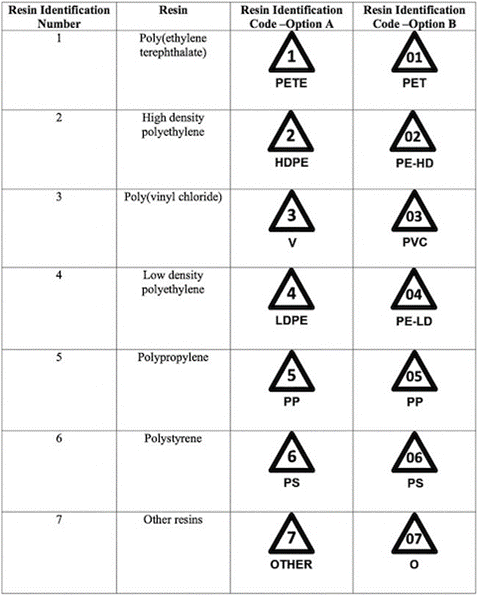
Source: ASTM International
Symbols indicating recycling used in the Member States of the European Union, including in Bulgaria
Labelling for recycling of packaging and type of the material from which it is made /identification number and abbreviation of the material/
Directive 94/62/ЕC of the European Parliament and of the Union from December 20, 1994 regarding the packaging and packaging waste, enforced obligations on persons who release packaged goods on the European Union market, to ensure compliance of the packages with certain requirements. Part of these requirements are related to the provision of the possibility of recycling or other utilization of the packaging after the end of their lifespan, as well as to marking the packaging with an identification number and abbreviation of the material from which it is made.
The specific marking method indicating the type of material from which the packaging is made, is regulated by the European commission by Decision 97/129/ЕC with regard to the establishment of identification system of the packaging materials. The system contains alphanumerical codes identifying the material from which the packaging is made.
The figures from 1 to 19 mean that the packaging is made of plastics; from 20 to 39 – from paper and cardboard, from 40 to 49 – metals, from 50 to 59 – wood materials; from 60 to 69 – textiles; from 70 to 79 – glass; from 80 to 99 – from composite materials, i.e. consists of two or more materials. In addition to the identification numerical code, abbreviations have been introduced with regard to the type of plastics, metal, glass, etc.
In Bulgaria, these requirements have been introduced by the Regulation on Packaging and Packaging Waste, which are described in details in Annexes to the Regulation. The packaging must be labelled with a recycling symbol:

Marking for recycling of packaging in Bulgaria
In the middle, between the three arrows are placed the abovementioned figures from 1 to 99, and the abbreviation (with capital letters in Latin) of the specific material of the packaging should be placed below the graphic sign.
For composite packaging is used the letter “С” followed by a slash (С/), and then the abbreviation for the specific components should be written, divided by slashes (for example, for packaging of paper, polyethylene and aluminum is used the abbreviation С/РАР/РЕ/ALU).
| Material of the packaging | Abbreviation | Identification code | Material of the packaging | Abbreviation | Identification code |
| Plastics | Textiles | ||||
| Polyethylene terephthalate | PET | 1 | Cotton | ТЕХ | 60 |
| Polyethylene with high density | HDPE | 2 | Jute | ТЕХ | 61 |
| Polyvinyl chloride | PVC | 3 | Other textile | ТЕХ | 62 – 69 |
| Polyethylene with low density | LDPE | 4 | Glass | ||
| Polypropylene | PP | 5 | Colorless glass | GL | 70 |
| Polystyrene | PS | 6 | Green glass | GL | 71 |
| Other plastics | – | 7 – 19 | Brown glass | GL | 72 |
| Other glass | GL | 73 – 79 | |||
| Paper and cardboard | Composite materials | ||||
| Corrugated board | PAP | 20 | Paper and cardboard/metals | 80 | |
| Other cardboard | PAP | 21 | Paper and cardboard /plastics | 81 | |
| Paper | PAP | 22 | Paper and cardboard /aluminum | 82 | |
| Paper | PAP | 23 – 39 | Paper and cardboard /white laminated iron | 83 | |
| Metals | Paper and cardboard / plastics/aluminum | 84 | |||
| Steel | FE | 40 | Paper and cardboard / plastics/aluminum /white laminated iron | 85 – 89 | |
| Aluminum | ALU | 41 | plastics/aluminum | 90 | |
| Other metals | – | 42 – 49 | plastics/ white laminated iron | 91 | |
| Wood materials | plastics/metals | 92 – 94 | |||
| Wood | FOR | 50 | glass/plastics | 95 | |
| Cork | FOR | 51 | glass /aluminum | 96 | |
| Other wood materials | FOR | 52 – 59 | glass / white laminated iron | 97 | |
| glass /metals | 98 – 99 |
If we compare the identification code of plastics developed by the US Plastic Industry Association, the marking system in the European Union is analogous, as it is added with other types of materials.
Separate collection marking
With the development of the European waste legislation and the increased recycling targets for different types of waste, separate collection symbols also have been introduced, which are also used to mark other types of goods and items that can be recycled (other than packaging), for example, such as batteries and accumulators, electrical and electronic equipment and so on. The design of the symbols is regulated by European directives, respectively by regulations of the Bulgarian legislation.
The separate collection marking means that after the use of the respective product and its turning into waste, it must be disposed of only in certain places in specialized containers, which will allow its subsequent recycling or other way of recovery. The purpose of this marking is to „remind“the users that throwing a product that has this symbol on it, in the containers for mixed household waste is not desirable and shouldn’t be allowed.
The symbols used to identify the separate collection are: the so-called „man with a trash bin“, which is used to mark packaging and strike out container that is used to mark batteries and accumulators, also electrial and electronic equipment and other items made of recyclable materials.
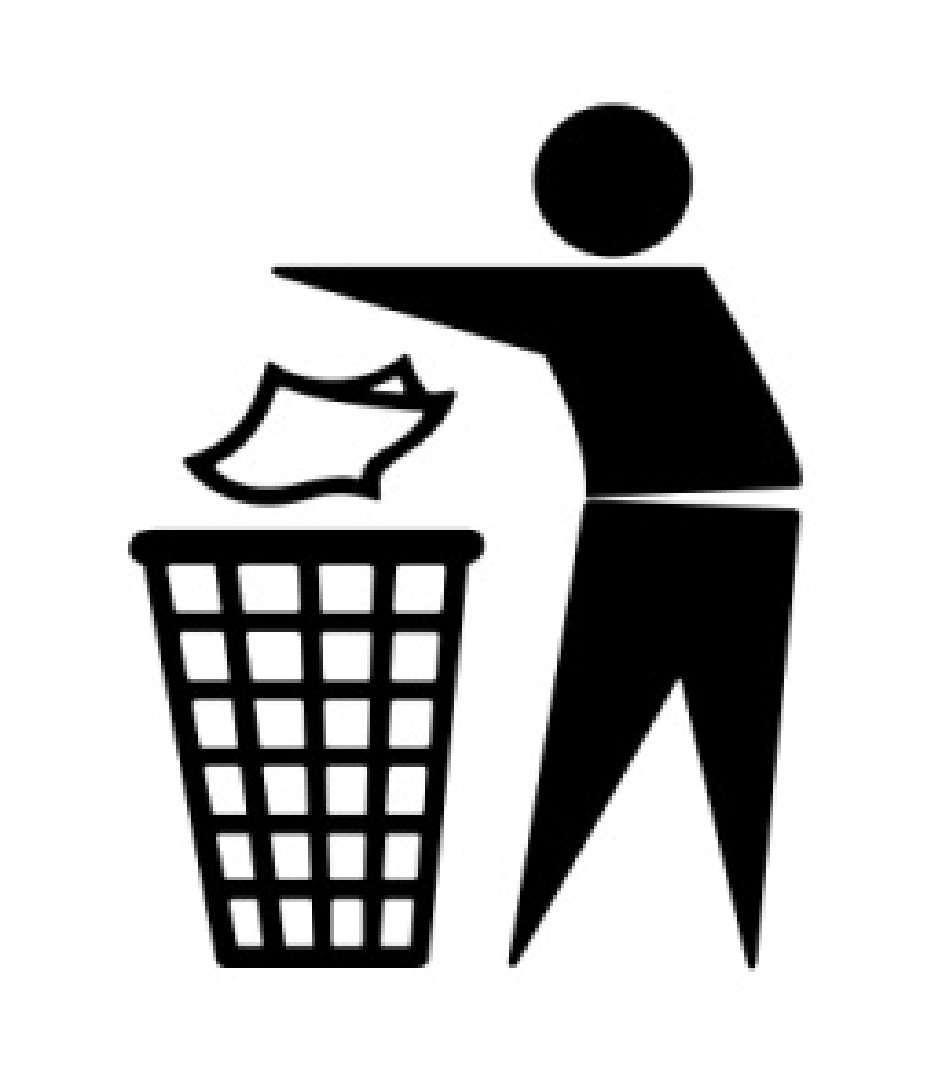 Symbol identifying separate collection of packaging | 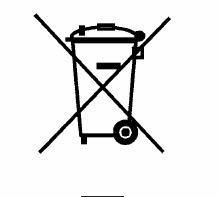 Symbol identifying separate collection of batteries and accumulators, electrical and electronic equipment |
Green dot
The green dot is an embodiment of the principle „responsibility of the manufacturer“, as set in the European waste management legislation and it is used not only to mark packaging. The symbol is a trademark throughout the world.
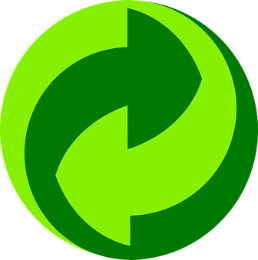 Green dot(Green dot, Grüne Punkt) | When a full color printing is available, the symbol is printed in light and dark green (Pantone 366C and 343C).In order to reduce costs or to avoid visual collision with other symbols, many producers choose black and white or other color combination to indicate the symbol on their packaging. |
The green dot doesn’t necessarily mean that the packaging is recyclable, that it will be recycled or that it is made of recycled material. This is a symbol used on the packaging in most European countries, including in Bulgaria, which means that the respective producer has made a financial contribution for the recovery and recycling of packaging waste in Europe. The presence of a green dot on a given packaging means that it is included in a system for collective recovery of packaging waste.
History of the symbol: the green dot is a symbol designed in the beginning of the 1990s, by Klaus Töpfer, German Minister of the Environment. In 1991 the German government adopted a law on packing, which requires the producers to take care of recycling or for the disposal of any packaging material they sell. As a result of the application of this law, the German industry created the so-called „dual system“ for waste collection, which collects household packaging waste alongside with the already established by that period municipal systems for waste collection. This system, funded by the manufacturers of packaged goods, is operated in Germany by Duales System Deutschland GmbH or, in short, DSD.
In 1994, the European parliament adopted Decree 94/62/ЕU with regard to packagings and packaging waste, which introduces analogous obligations for packaging producers across the EU. This led to the establishment in 1995 of non-governmental organization PRO EUROPE (Packaging Recovery Organization Europe) based in Brussels.
Since 1996, DSD has granted PRO EUROPE the right to use the „green dot“ trademark in the form of a global license on the territory of the European Union. At present, the right to place this symbol on their product packaging (for a fee) have more than 130 000 companies in 27 European countries. Licensee in Bulgaria is „Еcopack Bulgaria“АD – organization for recovery of packaging waste.


